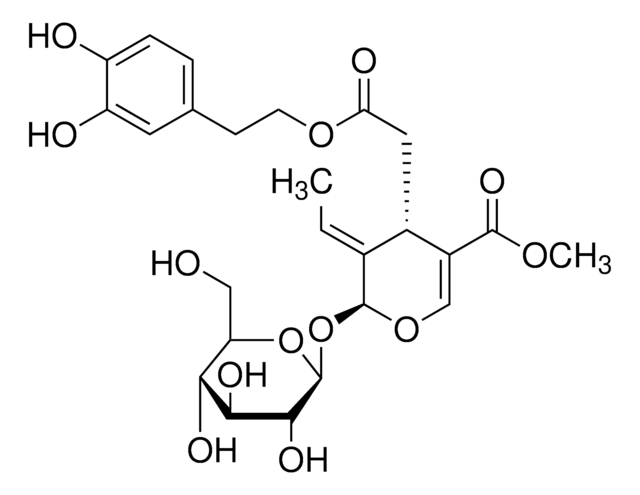M3547
Mangiferin Mangifera indica
Synonym(s):
1,3,6,7-Tetrahydroxyxanthone C2-β-D-glucoside
About This Item
Recommended Products
Assay
≥98% (TLC)
Quality Level
form
powder
application(s)
metabolomics
vitamins, nutraceuticals, and natural products
SMILES string
OC[C@H]1O[C@H]([C@H](O)[C@@H](O)[C@@H]1O)c2c(O)cc3Oc4cc(O)c(O)cc4C(=O)c3c2O
InChI
1S/C19H18O11/c20-4-11-15(25)17(27)18(28)19(30-11)12-8(23)3-10-13(16(12)26)14(24)5-1-6(21)7(22)2-9(5)29-10/h1-3,11,15,17-23,25-28H,4H2/t11-,15-,17+,18-,19+/m1/s1
InChI key
AEDDIBAIWPIIBD-ZJKJAXBQSA-N
General description
Application
- as a reference standard for the characterization of mangiferin from Mangifera indica using ultrasound with three-phase partitioning (UTPP)
- to study its effects in promoting brown adipose phenotype murine C3H10T1/2 mesenchymal stem cells (MSCs) and its role in mitochondrial biogenesis and homeostasis
- as a reference standard for the quantitative determination of markers compounds in the culture Swertia paniculata shoot culture using high-performance thin-layer chromatography (HPTLC)
Biochem/physiol Actions
Signal Word
Danger
Hazard Statements
Precautionary Statements
Hazard Classifications
Acute Tox. 1 Oral
Storage Class Code
6.1A - Combustible acute toxic Cat. 1 and 2 / very toxic hazardous materials
WGK
WGK 3
Flash Point(F)
Not applicable
Flash Point(C)
Not applicable
Personal Protective Equipment
Certificates of Analysis (COA)
Search for Certificates of Analysis (COA) by entering the products Lot/Batch Number. Lot and Batch Numbers can be found on a product’s label following the words ‘Lot’ or ‘Batch’.
Already Own This Product?
Find documentation for the products that you have recently purchased in the Document Library.
Customers Also Viewed
Our team of scientists has experience in all areas of research including Life Science, Material Science, Chemical Synthesis, Chromatography, Analytical and many others.
Contact Technical Service
